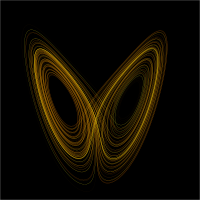
Photo from wikipedia
TwoChinese physicists, pioneers in the applications of these methods in the field of nonlinear dynamics and chaos, are the authors of this monograph. Hardly can the effort they made in… Click to show full abstract
TwoChinese physicists, pioneers in the applications of these methods in the field of nonlinear dynamics and chaos, are the authors of this monograph. Hardly can the effort they made in writing the book be understood, if one ignores the effort they made in the 1980s of the past century to lead this research work in the world. Numerous publications had appeared in the best physics journals by members of the scientific school led by Prof. Bailin Hao in Beijing, before the publication of the first edition appeared in 1998. Symbolic dynamics was originated as a general method to study dynamical systems at large, in which context its techniques have been developed and applied. Nevertheless, its ideas and techniques are so basic and of general application that it is no surprise that nowadays they have found significant applications in other areas in science. When teaching nonlinear dynamics, one of the very first questions is to explain that dynamical systems are the object of study, and that they may be continuous or discrete depending on how we measure time. In symbolic dynamics, time is always measured in discrete intervals, indicating the particular state in which the system is. A symbol is associated to each state and the dynamics is described by an infinite sequence of symbols. When we have a continuous dynamical system, then we would need to discretise the system to get a coarse-grained description of the dynamics. The methods and techniques of symbolic dynamics constitute a very rich and fruitful way to attack the analysis of dynamics. Interestingly, the field has been built by many brilliantmathematicians. Historically, we need to remember one key paper written by the French mathematician Jacques Hadamard in 1898, though the first systematic study was done by Marsten Morse and Gustav Hedlund in the 1940s of the last century, who as a matter of fact coined the term symbolic dynamics. Similar ideas applied in the analysis of second-order differential equations were developed by key figures in the history of chaos theory bymathematicians like George Birkhoff, Norman Levinson, Mary Cartwright and J. E. Littlewood. The last ones, it is noteworthy to mention, participated in the radar project during World War II and the well-known van der Pol oscillator was the object of their studies. Also, Claude Shannon used symbolic sequences and shifts of finite type in the 1940s to code information channels. Subsequently, the techniques were extensively used in ergodic theory, topological and hyperbolic dynamics, information theory and complex dynamics. The influence of the methods from symbolic dynamics in chaos theory has been very extensive, and one of them is the Sharkovskii’s theorem in 1964 about periodic orbits of a continuous map of an interval into itself that was a real milestone. Symbolic dynamics provides a rigorous way to understand global properties and constitutes an enormous help to characterise chaotic motion, as well as periodic motion, in dynamical systems.Many students of nonlinear dynamics and chaos have learned the rudiments of symbolic dynamics to some extent, since basic ideas form part of the usual contents in many books. However, it is obvious that its abstract formulation has oftentimes been an obstacle for using its techniques by scientists outside the mathematics community, such as physicists and engineers. This clearly poses a dilemma, since symbolic dynamics is a practical tool in studying chaotic dynamics, and at the same time most of the literature has been mathematically oriented. From this point of view, this book constituted one of the first attempts to offer applications of symbolic dynamics to physicists and engineers. The reader can find a description of the most important discrete dynamical systems, all of them analysed with detail. Furthermore, in this second edition, the authors have revised mainly applications to ordinary differential equations and their corresponding Poincaré maps. Moreover, an extensive bibliography and many computer codes are also offered, what supposes a help for the student who wants to enter the field. The book can be considered a classic in the field, containing very useful and important information for any researcher and student interested in chaotic dynamics, independently of the focus of study. It can be convenient for teaching the subject to graduate students, as well for self-study and a good reference in the library of any scientist interested in methods of chaotic dynamics.
Journal Title: Contemporary Physics
Year Published: 2019
Link to full text (if available)
Share on Social Media: Sign Up to like & get
recommendations!